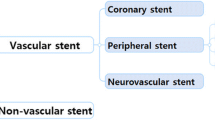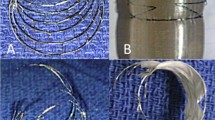Abstract
As a child grows, limitations to the maximum dilatable stent diameter (MDD) will result in stenosis associated with size mismatch. If an implanted stent can be intentionally fractured along its length, a process called “unzipping,” it may eventually be redilated to adult vessel size. Few studies have addressed how a stent can be unzipped using an ultra-high-pressure balloon (UHB) with the smallest balloon diameter. Eleven commercially available stents, three Liberté stents (LS), six genesis renal stents (GS), and two express vascular SD stents (ES), were tested for in vitro unzipping. In addition, using eight stents, we investigated whether a balloon that had unzipped the stent in vitro would work similarly in the vessel of a pig. Finally, we assessed the histological influence of the unzipped stent on the surrounding tissue. In a bench test, LS, GS, and ES were consistently unzipped by a balloon whose diameter was ≥ 1.5, 2.18, and 1.66 times that of MDD, respectively. In animal experiments, LS, GS, and ES were predictably unzipped with balloons of 1.50, 1.81, and 1.66 times the MDD, respectively. After unzipping, the unzipped strut did not damage the surrounding tissue histologically. Use of a UHB enabled unzipping of the stent with a balloon diameter less than two times the MDD enables implantation of a larger stent in the unzipped small stent by incremental steps.




Similar content being viewed by others
References
O’Laughlin MP, Perry SB, Lock JE, Mullins CE (1991) Use of endovascular stents in congenital heart disease. Circulation 83:1923–1939
Mori Y, Takahashi K, Nakanishi T (2013) Complications of cardiac catheterization in adults and children with congenital heart disease in the current era. Heart Vessel 28(3):352–359
Schwartz RS, Huber KC, Murphy JG, Edwards WD, Camrud AR, Vlietstra RE, Holmes DR (1992) Restenosis and proportional neointimal response to coronary artery injury: results in a porcine model. J Am Coll Cardiol 19:267–274
Sathanandam SK, Haddad LM, Subramanian S, Wright D, Philip R, Waller BR (2015) Unzipping of small diameter stents: an in vitro study. Catheter Cardiovasc Interv 85(2):249–258
Morray BH, McElhinney DB, Marshall AC, Porras D (2016) Intentional fracture of maximally dilated balloon-expandable pulmonary artery stents using ultra-high-pressure balloon angioplasty: a preliminary analysis. Circ Cardiovasc Interv 9(4):e003281
Sathanandam SK, Kumar TK, Hoskoppal D, Haddad LM, Subramanian S, Sullivan RD, Zurakowski D, Knott-Craig C, Waller BR 3rd (2016) Feasibility and safety of unzipping small diameter stents in the blood vessels of piglets. JACC Cardiovasc Interv 9(11):1138–1149
Grohmann J, Sigler M, Siepe M, Stiller B (2016) A new breakable stent for recoarctation in early infancy: preliminary clinical experience. Catheter Cardiovasc Interv 87(4):E143–E150
Ing FF, Fagan TE, Kearney DL (1996) A new “open-ring” stent. Circulation 94:1–57 (abstract)
Goodfriend AC, Welch TR, Barker G, Ginther R Jr, Riegel MS, Reddy SV, Wang J, Nugent A, Forbess J (2015) Novel bioresorbable stent coating for drug release in congenital heart disease applications. J Biomed Mater Res A 103(5):1761–1770
Acknowledgments
We would like to thank Dr. Peter M. Olley, Professor Emeritus, University of Alberta, Canada, for providing linguistic advice.
Author information
Authors and Affiliations
Corresponding author
Ethics declarations
Conflict of interest
The author received a research grant from Miyata Cardiac Research Promotion Foundation.
Ethical approval
All procedures performed in studies involving animals were in accordance with the ethical standards of the institution or practice where the studies were conducted.
Rights and permissions
About this article
Cite this article
Fujimoto, K., Fujii, T., Hata, Y. et al. Stent unzipping using an ultra-high-pressure balloon: in vitro and animal experiments. Heart Vessels 33, 239–245 (2018). https://doi.org/10.1007/s00380-017-1060-x
Received:
Accepted:
Published:
Issue Date:
DOI: https://doi.org/10.1007/s00380-017-1060-x




